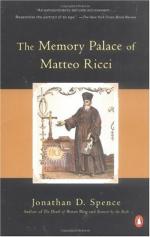
|
| Name: _________________________ | Period: ___________________ |
This test consists of 15 multiple choice questions and 5 short answer questions.
Multiple Choice Questions
1. During the Renaissance, what did some believe was the purpose of these groups in China that "pledged themselves to lives of heightened spiritual service"?
(a) Political organizations to unionize the Chinese workers.
(b) Government infiltration of religious groups.
(c) Clandestine recruitment organizations for the Jesuits.
(d) Social clubs to entertain wealthy Chinese businessmen.
2. During the Renaissance, why were the Jesuits NOT considered a mendicant order?
(a) They did not practice chastity.
(b) They did not live in poverty.
(c) They did not engage in teaching assignments.
(d) They did not practice obedience to the Pope.
3. According to "Chapter Eight, The Fourth Image: The Fourth Picture", what effect did Ricci's reflections on the Virgin Mary have on him?
(a) They make him nervous.
(b) They provide him with Chinese friends.
(c) They give him solace.
(d) They make him sad.
4. What was the state of Ricci's financial situation during most of his time in China?
(a) Unstable, ranging from poverty to riches on a steady basis.
(b) Increasing, as more wealthy Chinese convert to Christianity and begin to tithe to his church.
(c) Poverty, with a constant threat of bankruptcy and expulsion.
(d) Stable, with regular subsidies from his Jesuit order.
5. What does the first picture depict in the series of prints that made up the third picture, "The Men of Sodom"?
(a) Lot, Lot's wife, and their two daughters running away from the city before it is destroyed.
(b) God promising to destroy Sodom because of its wickedness.
(c) Lot's daughters get Lot drunk and sleep with him in order to continue their family line.
(d) God blinding the men of Sodom when they try to rape the angels.
6. Why did Ricci wish he had more money during the 16th century when he was in China?
(a) To bribe government officials to leave his mission alone.
(b) To build a new church for his Christian converts.
(c) To provide more financial resources to the impoverished Chinese farmers.
(d) To buy books to further his plans for the conversion of the Chinese people.
7. Who or what urged penalties on Christians who participated with the Japanese in the Japanese use of financial tricks to make money during the 16th century?
(a) The Council of Trent.
(b) Pope Leo XII.
(c) Matteo Ricci.
(d) The Japanese government.
8. What did Ignatius encourage the Jesuits to publish when they published their first books in the 16th century?
(a) Only religious works.
(b) Greek works.
(c) Latin works.
(d) Writings of the Jesuits.
9. According to "Chapter Five, The Second Picture: The Road to Emmaus", what did Ricci teach to the Chinese that he compared to branches of a stream?
(a) Science.
(b) Mathematics.
(c) Agriculture.
(d) Language.
10. When they were in their missions during the 16th century, why did Ricci and Ruggieri often want money?
(a) To travel outside the major cities to preach to the people in the countryside.
(b) To pay for transportation for the Chinese to come to the city.
(c) To procure the proper gifts for the Chinese to impress them.
(d) To buy Bibles for the fifteen Christian converts.
11. During the Renaissance, what were the Jesuits searching for in their publications?
(a) The ideal page size.
(b) The sturdiest paper.
(c) The highest quality ink.
(d) The perfect font.
12. When Ricci became a missionary in China during the 16th century, what was wrong with the science taught to the Chinese?
(a) It focused on outdated principles.
(b) It disregarded Western discoveries and advances.
(c) It led to many disasters to the environment.
(d) It lacked fundamental principles.
13. When Ricci was a missionary in 16th century China, whom did the Chinese people fear?
(a) Buddhist monks.
(b) Foreign invaders.
(c) Jesuit missionaries.
(d) The Chinese ruler.
14. What did the fourth ideograph, "hao," represent in the Chinese language during the 16th century?
(a) Chastity.
(b) Poverty.
(c) Obedience.
(d) Goodness.
15. During the 16th century, how did the way Ignatius Loyola wanted students to learn affect Matteo Ricci?
(a) Ricci chose to become a Jesuit.
(b) Ricci developed his mnemonic technique.
(c) Ricci argued with his instructors about the method's futility.
(d) Ricci rose to the top of his class.
Short Answer Questions
1. Where did Ricci place the new picture of the fourth idiograph "hao" in the Memory Palace?
2. What did Ricci NOT like about the Confucian moral system when he was a missionary in the 16th century?
3. According to "Chapter Seven, The Third Picture: The Men of Sodom", who promoted morality in China during the 16th century?
4. What two moral extremes were seen in Rome during the mid-16th century?
5. Who was arrested, beaten and imprisoned for trying to make money by keeping tribute given to the guards at the Xiangshan border during the 16th century when Ricci was in China??
|
This section contains 823 words (approx. 3 pages at 300 words per page) |

|




